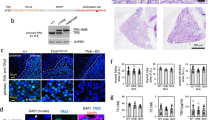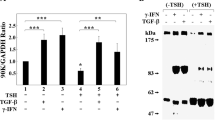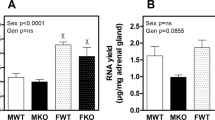Abstract
TYROSINE aminotransferase (TAT) is not inducible by corticosteroid hormones in heterokaryocytes and hybrid cells resulting from the fusion of rat hepatoma cells with mouse fibroblasts1,2. Fusion of rat hepatoma cells with human fibroblasts also results in the loss of TAT inducibility, but because of the unidirectional loss of human chromosomes in the resulting hybrid cells3, inducibility of TAT is re-expressed in some clones4. The suppression or modulation of the expression of TAT inducibility in such hybrid clones seems to be related to presence of the human X chromosome4. Since rat–human hybrid clones in which TAT inducibility is suppressed have the same corticosteroid receptor activity as the rat parental cells4, the absence of inducibility cannot be ascribed to a decrease in corticosteroid receptor activity.
This is a preview of subscription content, access via your institution
Access options
Subscribe to this journal
Receive 51 print issues and online access
$199.00 per year
only $3.90 per issue
Buy this article
- Purchase on Springer Link
- Instant access to full article PDF
Prices may be subject to local taxes which are calculated during checkout
Similar content being viewed by others

References
Thompson, E. B., and Gelehrter, T. D., Proc. natn. Acad. Sci. U.S.A., 68, 2589–2593 (1971).
Schneider, J. A., and Weiss, M. C., Proc. natn. Acad. Sci. U.S.A., 68, 127–131 (1971).
Croce, C. M., Kieba, I., and Koprowski, H., Expl Cell Res., 79, 461–463 (1973).
Croce, C. M., Litwack, G., and Koprowski, H., Proc. natn. Acad. Sci. U.S.A., 70, 1268–1272 (1973).
Croce, C. M., Bakay, B., Nyhan, W. L., and Koprowski, H., Proc. natn. Acad. Sci. U.S.A., 70, 2590–2594 (1973).
Dubbs, D. R., and Kit, S., Expl Cell Res., 33, 19–28 (1964).
Ricciuti, F., and Ruddle, F. H., Nature new Biol., 241, 180–182 (1973).
Croce, C. M., Koprowski, H., and Eagle, H., Proc. natn. Acad. Sci. U.S.A., 69, 1453–1456 (1972).
Littlefield, J. W., Expl Cell Res., 41, 190–196 (1966).
Seabright, M., Lancet, ii, 971–972 (1971).
Canellakis, Z. N., and Cohen, P. P., J. biol. Chem., 222, 53–62 (1956).
Lowry, O. H., Rosebrough, N. J., Farr, A. L., and Randall, R. J., J. biol. Chem., 143, 265–275 (1951).
Litwack, G., and Singer, S., in Biochemical actions of hormones (edit. by Litwack, G. ), 2, 113–163 (Academic Press, New York, 1972).
Singer, S., Becker, J. E., and Litwack, G., Biochem. Biophys. Res. Commun., 52, 943–950 (1973).
Litwack, G., Filler, R., Rosenfield, S. A., Lichtash, N., Wishman, C. A., and Singer, S., J. Biol. Chem., 248, 7481–7486 (1973).
Penman, S., in Fundamental techniques in virology (edit. by Habel, K., and Salzman. N. P.), 35–48 (Academic Press. New York, 1969).
Author information
Authors and Affiliations
Rights and permissions
About this article
Cite this article
CROCE, C., KOPROWSKI, H. & LITWACK, G. Regulation of the corticosteroid inducibility of tyrosine aminotransferase in interspecific hybrid cells. Nature 249, 839–841 (1974). https://doi.org/10.1038/249839a0
Received:
Issue Date:
DOI: https://doi.org/10.1038/249839a0
This article is cited by
Comments
By submitting a comment you agree to abide by our Terms and Community Guidelines. If you find something abusive or that does not comply with our terms or guidelines please flag it as inappropriate.


